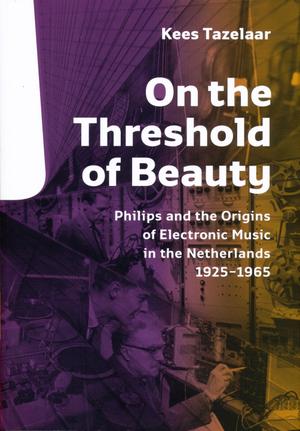
Index
Contents
Foreword by Daniel Teruggi 7
Introduction 9
Part I
Electroacoustics and Electronic Music at
Philips Research Laboratories
1 Developments in Electroacoustics at Philips before 1945 17
Philips Research Laboratories - 17
Radios and Loudspeaker Development - 18
Film Sound: The Loetafoon and the Film ”Philips Radio” - 22
The Philips-Miller Recording System - 26
Stereophonic Sound - 28
Synthetic Sound - 33
The Philiolist Loudspeaker Violins - 36
2 After World War II: Towards Electronic Music 38
”Canned Music" and a Music Laboratory - 38
Collaboration with Leopold Stokowski - 40
Leopold Stokowski and Roelof Vermeulen at the Concertgebouw - 45
Multiplication of Concerts - 50
Ambiophonics and Reverberation - 53
IThe Gravesano Music and Electroacoustics Conference - 59
Electronic Musical lnstrumen ts for the Fair of Science - 62
3 The Studio at Philips Research Laboratories 64
Henk Badings and the Nederlandse Radio Unie - 64
Henk Badings’ ”Ka'in en Abel” and the Studio Equipment in Room 306 - 66
”Variations électroniques" and Philips’ Commercial Animation Films - 72
The Electronic Popular Music of Dick Raaijmakers, aka Kid Baltan - 77
Tom Dissevelt’s ”Electronic Movements" - 80
More Electronic Music by Henk Badings - 83
Ton de Leeuw's ”Antiphonie” for Wind Quintet and Electronic Sounds - 86
The Composer Dick Raaijmakers - 87
The End of the Studio in Eindhoven - 93
Part II
Electronic Music for the Philips Pavilion
4 Preliminary Technical and Artistic Outline 101
Initial Concept -101
The Electroacoustic Division (ELA) and Its Studio -106
ELA at the 1958 World's Fair -109
Sound and Light Spectacles -101
5 Realizing the Music for the Philips Pavilion
Le Corbusier, Edgar Varèse, Iannis Xenakis: Artistic Considerations -114
Philips' Doubt about Edgar Varèse -118
The Garage at Strijp III and Willem Tak's Test Scenario -120
Edgard Varèse in Eindhoven and Preparations for Musical Production - 127
The Laborious Recording of "Le poème èlectronique" -139
Anton Buczynsky's Contribution -144
The Integration of Reverberation and Panning -147
Iannis Xenakis' "Interlude sonore" -153
6 Le poème èlectronique in Brussels 157
The SoundInstallation -157
Edgard Varèse in Brussels -166
Presenting "Le poème electronique" to the Public -168
Part III
Electronic Music Pervades Public Culture:
Organizations, tudios, Concerts, Education
7 The First Steps towards a Dutch Electronic Music Studio 172
Walter Maas and the Founding of Gaudeamus - 172
Werner Meyer-Eppler's Lectures -174
Electronic Music at the Nederlandse Radio Unite -175
8 An Organization for the Promotion of Electronic Music 177
The Contactorgaan Elektronische Muziek -177
Defining Electronic Music and Staging the First Concert - 180
The International Days of Experimental Music at the 1958 World's Fair - 185
9 A Temporary Studio for Electronic Music Education and Production 188
A Studio at Technische Hogeschool Delft - 188
Electronic Music for Film and Theater - 192
The Composers Jan Boerman and Rudolf Escher - 197
10 Continuing the Work of the Philips and TH Delft Studios in Utrecht
and Bilthoven 200
Plans for New Studios in Utrecht and Amsterdam - 200
New Studios in Utrecht and Bilthoven - 206
Tom Dissevelt’s ”lntersection,” Dick Raaijmakers’ ”Vijfplastieken,”
Jan Boermanls "A]ehemie 1951" and Rudolf Escher's
"Summer Rites at Noon” ' 209
The Battle over Leadership of the Studio in Utrecht - 213
Gottfried Michael Koemg at Gaudeamus: Critical Remarks on
Sound Spatialization 219
The Bilthoven Electronic Music Course - 222
The Utrecht Studio under Henk Badings and Rudolf Escher's
Final Attempt - 224
Tom Dissevelt’s ”Fantasy in Orbit" - 226
11 Private Projects 230
The Mood Engineering Society - 230
The First Private Studios and Their Early Productions: Jan Boerman,
Ton Bruynel, Dick Raaijmakers - 231
12 Towards Stability in Utrecht and The Hague 246
Gottfried Michael Koenig's Formative Years - 246
Koenig at the Cologne Studio - 250
Koenig at STEM - 255
Kees van Baaren and the Establishment of a Studio at the
Royal Conservatoire 262
Acknowledgements 266
List of illustrations 268
Notes 269
References 296
Appendix: Foreign Quotations in Original Languages 300
Index 307


